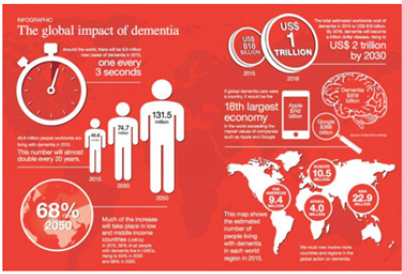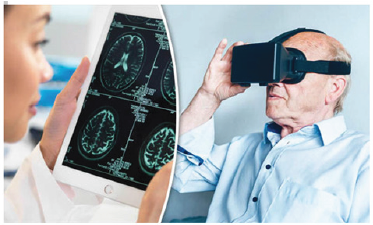- Submissions

Full Text
Gerontology & Geriatrics Studies
A Virtual World for Dementia
Ananya Jain*, Arundhati Guha Thakurta and Indresh Kumar Verma
NMIMS-School of Design, India
*Corresponding author:Ananya Jain, NMIMS-School of Design, India
Submission: August 29, 2022; Published: February 28, 2023

ISSN 2578-0093Volume8 Issue3
Executive Summary
With the gradual rise in the technology and medical industries, healing and finding cures has become easier. In today’s world most facilities are readily available at times of emergencies. Healthcare has greatly improved over the years. Taking into consideration the number of health issues all around, we need to live up to the saying ‘health is wealth’ and ‘with a healthy body comes a healthy mind’ because being healthy is not only about being fit but is also a necessity for survival. Unfortunately, we can’t completely satiate the saying because not every disease has a cure. From cancer to muscular dystrophy to dementia, the list is endless. Dementia wasn’t taken up until a lot of people started to suffer and develop symptoms which drew concern to the matter at hand. Researchers and scientists took up the challenge to find the cure for the same but so far have been unsuccessful. The recent growth in technology gives us hope that maybe one-day dementia will have a cure. This white paper talks about how we can give dementia patients a new path of recovery and a way for them to trigger those memories and incidents using VR with built-in multisensory design.
Keywords:Dementia; Cancer; Symptoms; Chronic disease; Virtual reality; Diagnosis
Introduction
Imagine waking up one day and you forget about everything that revolves around you, your loved ones, your whole life, every memory, every milestone. Simple things get harder to comprehend and you can’t even have a proper conversation without saying ‘what?’ a couple of times. Imagine not stepping out of the house in the fear of not being able to find your way back. This is something dementia patients go through every day. Dementia is an impairment that mainly affects the elderly and their ability to think, reason, make decisions etc. Alzheimer’s disease is the most common type of dementia; it is caused by damage to or changes in the brain. A few symptoms can be memory loss, forgetfulness, poor judgment, and loss of thinking abilities (Division of Population Health, National Center for Chronic Disease Prevention and Health Promotion [1]). Around 55 million people have dementia worldwide. With over 60% living in low-and middle-income countries (Figure 1). As the proportion of senior citizens in the population is increasing in nearly every country, this number is expected to rise to 78 million in 2030 and 139 million in 2050 [2].
Figure 1:Infographic dementia and the world [12].

Forms of Dementia [3]
a. Alzheimer’s disease is caused by changes in the brain [4].
It is the most common dementia diagnosis among older adults,
it’s what most people think when they hear ‘dementia’. Memory
loss is one of the first symptoms.
b. Frontotemporal dementia, a rare form of dementia that
occurs to people below 60, it’s caused due to cell damage in
the brain which leads to them not being able to control their
actions, personality change, balance problems etc.
c. Lewy body dementia, caused by protein deposits in the
brain which leads to hallucinations, and problems in thinking
clearly, forgetfulness etc.
d. Vascular dementia is a form of dementia that is caused by
conditions that damage blood vessels in the brain or interrupt
the flow of blood and oxygen to the brain. Unlike Alzheimer’s,
vascular dementia begins with poor judgment and poor
decision making.
e. Mixed dementia is a combination of two or more forms of
dementia.
Cure??
Currently there is no “cure” for dementia. Since dementia is caused by different diseases it is very unlikely for it to have a single cure. Huge strides have been made to understand how different diseases cause brain damage and so produce dementia. There are now many more research studies and clinical trials taking place, with increased funding over the past few years. Although there is no cure, hope is not lost. With new innovative technology, dementia patients can lead a new path to recovery. Medication and therapy are of course one of the major steps for dementia patients to get back on their feet but why not include multisensory environments where certain memories and instances could be triggered? one of the best parts of virtual reality is that it can be experienced anywhere as long as one has the equipment.
Virtual Reality
Figure 2:New VR jobs die down at Meta, Google amid hiring freeze: Report [13].

There has been a massive growth in technology over the years which has led to the formation of virtual reality. Virtual reality is a boon to the coming generations and the curious minds. The fact that we could just virtually teleport ourselves to a whole new world in the click of a button is very intriguing. Virtual Reality (VR) is a computer-generated environment, with objects and scenes that appear to be real which makes the user feel that they are immersed in their surroundings [5]. This environment is now experienced through a device known as a Virtual Reality headset or helmet. VR allows us to immerse ourselves in a completely different virtual world where we are one of the characters. VR gives us the opportunity to explore things we can’t in the real world (Figure 2).
Medical Diagnosis with the Help of VR
Virtual reality is an innovative and revolutionary concept and its progress in the medical field is taking this technology to a whole new level. Virtual Reality is very effective for medical diagnosis. For a person suffering from cancer, during the long painful chemotherapy hours, this virtual reality headset can be used as a distraction from the pain [6]. The patient can create a virtual scenario of whatever gives them peace or eliminates stress, which makes their painful journey a little more bearable and easier. They can be sitting at a hospital bed and at the same time explore the beautiful city of Jaipur or take a walk in the fort. The same can be done for dementia patients. These patients have all their five senses active but it’s the damage in the brain that causes their senses to get suppressed. Virtual reality can create a multi-sensory environment for these patients where all their senses get triggered (Figure 3). The virtual environment could be designed in such a way that these people can relive certain moments or visit a place that could cause a memory rush and trigger certain emotions. A 2020 review of more than 20 studies found that VR reduced symptoms of anxiety, as well as depression and fatigue [6].
Figure 3:Dementia [14].

Dementia and VR
Dementia has no cure so far, but medicines and therapy are ways for these patients to cope up. Dementia is currently the seventh leading cause of death among all diseases and one of the major causes of disability and dependency among senior citizens worldwide. The cost of dementia is another issue to take into consideration. The worldwide cost of dementia is $818 billion, and it will become a trillion by 2018. In the UK the cost of dementia estimated in 2013 was 26.3 billion pounds; 4.3 billion were spent on healthcare costs, of which around 85 million were spent on diagnosis [7]. Therefore, it is necessary to develop affordable diagnosis and support tools to help limit the increasing cost that is associated with dementia. This is where VR can play a major role in the diagnosis, it may not be able to cure the person, but it definitely is worth a shot. There are facilities already using VR as a diagnosis for many dementia patients. Patients with dementia, their families, and caregivers can clearly have positive benefits from VR, says Dr. Jim Ang, PhD, in discussion about a VR and dementia study on which he was a lead author. A richer and more satisfying quality of life is provided, than is otherwise available, with many positive outcomes [8]. Companies like MindMaze, Oxford VR, Limbix and Psious use VR in neurological therapy in hospitals and for individuals at home. The treatment differs according to the patient and the type and levels of severity of the neurological disease or disorder (Figure 4). Essentially helping them with skills including memory recall and navigation. Ang’s research, out of Kent, UK, found evidence in a small study that exposing people with dementia to VR environments also helps improve their interactions with caregivers and reduce aggression [8-10].
Figure 4:Virtual reality [15].

Conclusion
The person under the several layers of dementia is still the same fun old person they were always known as, it’s hard for them because they can’t remember their family but what’s worse is that they can’t even remember themselves, their accomplishments, their ups and downs, their whole life. They are forced to be dependent on somebody in order to live peacefully, they can’t make their own life choices. But there’s always hope in times of darkness and that’s what keeps us going. Virtual Reality has been one of the greatest inventions for the medical sector [11]. Dementia patients will now be able to thrive in the multisensory environment provided to them by the VR headset. Their dementia won’t go away but at least they’ll be able to relive and recall those moments and be on the path to recovery. Virtual reality is a step in the right direction and will be the future of various medical diagnoses and the healthcare industry. Hopefully in the future this becomes an affordable diagnosis worldwide and helps people fight dementia across the world [12- 16].
Call to Action
It is recommended by all healthcare and medical facilities to implement virtual reality therapy with specifically designed multisensory environments for people suffering from dementia for them to be able to continue living their lives without the fear of forgetting and never being able to remember.
References
- Division of population health, national center for chronic disease prevention and health promotion (2019) Alzheiemer’s disease and healthy aging, What is dementia?
- World Health Organization (2021) Dementia, Switzerland.
- National Institute on aging (2021) What is dementia? symptoms, types, and diagnosis, US.
- Stanford healthcare (2021) Alzheimer's disease causes.
- Iberdrola (2021) Virtual reality: Another world within sight, Spain.
- Delzell E, Nazario B (2021) Virtual reality in medicine.
- UN news (2017) UN health agency launches first global monitoring system for dementia, USA.
- Williams M (2020) What can VR Therapy do for dementia and Alzheimer’s?
- Martin PF, Casarella J (2020) Types of dementia.
- NHS (2020) Is there a cure for dementia? Dementia guide, England.
- Bayshore (2019) Virtual Reality: The next frontier for dementia care?
- The Alzheimer Society of Ireland (2017) Policy-on-dementia-in-Ireland, international work, Ireland.
- HR Economic Times (2022) New VR jobs die down at Meta, Google amid hiring freeze: Report, India.
- Scholarly community encyclopedia (2021) Dementia.
- Express (2017) Virtual reality game launched to help research into dementia, US.
- Eichenberg C (2012) Virtual Reality in Psychological, medical and pedagogical applications.
© 2023 Ananya Jain. This is an open access article distributed under the terms of the Creative Commons Attribution License , which permits unrestricted use, distribution, and build upon your work non-commercially.
 a Creative Commons Attribution 4.0 International License. Based on a work at www.crimsonpublishers.com.
Best viewed in
a Creative Commons Attribution 4.0 International License. Based on a work at www.crimsonpublishers.com.
Best viewed in 







.jpg)






























 Editorial Board Registrations
Editorial Board Registrations Submit your Article
Submit your Article Refer a Friend
Refer a Friend Advertise With Us
Advertise With Us
.jpg)






.jpg)














.bmp)
.jpg)
.png)
.jpg)










.jpg)






.png)

.png)



.png)






